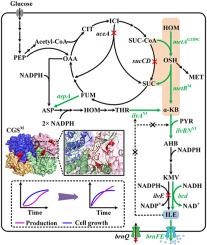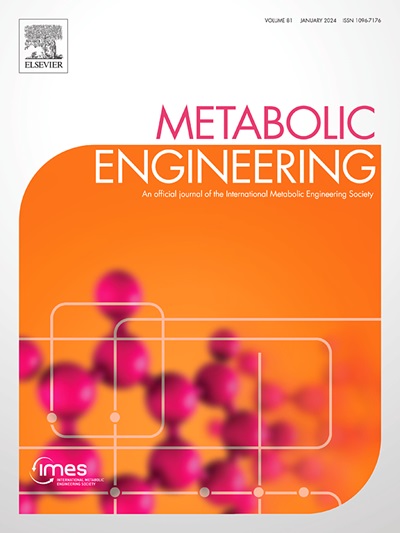通过代谢工程在大肠杆菌中生长耦合生产 L-异亮氨酸。
IF 6.8
1区 生物学
Q1 BIOTECHNOLOGY & APPLIED MICROBIOLOGY
引用次数: 0
摘要
L- 异亮氨酸是一种必需氨基酸,被广泛应用于制药和食品行业。然而,目前的生产效率不足以满足日益增长的需求。在本研究中,我们旨在培育一株高效的大肠杆菌 L-异亮氨酸生产菌株。首先,通过使用抗反馈酶实现了 L-异亮氨酸的积累。接着,通过引入基于 metA-metB 的α-酮丁酸生成旁路,建立了生长耦合的 L-异亮氨酸合成途径,将 L-异亮氨酸产量显著提高到 7.4 克/升。在使用从适应性实验室进化中获得的活性提高的胱硫醚γ-合成酶突变体后,L-异亮氨酸的产量进一步提高到 8.5 克/升。随后,通过绕过依赖 NADPH 的天冬氨酸氨基转移酶途径,采用依赖 NADH 的途径和反式氢化酶,提高了氧化还原通量。最后,通过改造转运系统提高了 L-异亮氨酸的外流。经过 48 小时的饲料批量发酵后,产生的菌株 ISO-12 的 L-异亮氨酸生产滴度达到 51.5 克/升,葡萄糖产量为 0.29 克/克。与之前报道的菌株相比,本研究开发的菌株实现了更高的 L-异亮氨酸生产效率。这些策略将有助于开发生产 L-异亮氨酸及相关产品的细胞工厂。本文章由计算机程序翻译,如有差异,请以英文原文为准。

Growth-coupled production of L-isoleucine in Escherichia coli via metabolic engineering
L-isoleucine, an essential amino acid, is widely used in the pharmaceutical and food industries. However, the current production efficiency is insufficient to meet the increasing demands. In this study, we aimed to develop an efficient L-isoleucine-producing strain of Escherichia coli. First, accumulation of L-isoleucine was achieved by employing feedback-resistant enzymes. Next, a growth-coupled L-isoleucine synthetic pathway was established by introducing the metA-metB-based α-ketobutyrate-generating bypass, which significantly increased L-isoleucine production to 7.4 g/L. Upon employing an activity-improved cystathionine γ-synthase mutant obtained from adaptive laboratory evolution, L-isoleucine production further increased to 8.5 g/L. Subsequently, the redox flux was improved by bypassing the NADPH-dependent aspartate aminotransferase pathway and employing the NADH-dependent pathway and transhydrogenase. Finally, L-isoleucine efflux was enhanced by modifying the transport system. After fed-batch fermentation for 48 h, the resultant strain, ISO-12, reached an L-isoleucine production titer of 51.5 g/L and yield of 0.29 g/g glucose. The strains developed in this study achieved a higher L-isoleucine production efficiency than those reported previously. These strategies will aid in the development of cell factories that produce L-isoleucine and related products.
求助全文
通过发布文献求助,成功后即可免费获取论文全文。
去求助
来源期刊

Metabolic engineering
工程技术-生物工程与应用微生物
CiteScore
15.60
自引率
6.00%
发文量
140
审稿时长
44 days
期刊介绍:
Metabolic Engineering (MBE) is a journal that focuses on publishing original research papers on the directed modulation of metabolic pathways for metabolite overproduction or the enhancement of cellular properties. It welcomes papers that describe the engineering of native pathways and the synthesis of heterologous pathways to convert microorganisms into microbial cell factories. The journal covers experimental, computational, and modeling approaches for understanding metabolic pathways and manipulating them through genetic, media, or environmental means. Effective exploration of metabolic pathways necessitates the use of molecular biology and biochemistry methods, as well as engineering techniques for modeling and data analysis. MBE serves as a platform for interdisciplinary research in fields such as biochemistry, molecular biology, applied microbiology, cellular physiology, cellular nutrition in health and disease, and biochemical engineering. The journal publishes various types of papers, including original research papers and review papers. It is indexed and abstracted in databases such as Scopus, Embase, EMBiology, Current Contents - Life Sciences and Clinical Medicine, Science Citation Index, PubMed/Medline, CAS and Biotechnology Citation Index.
 求助内容:
求助内容: 应助结果提醒方式:
应助结果提醒方式:


